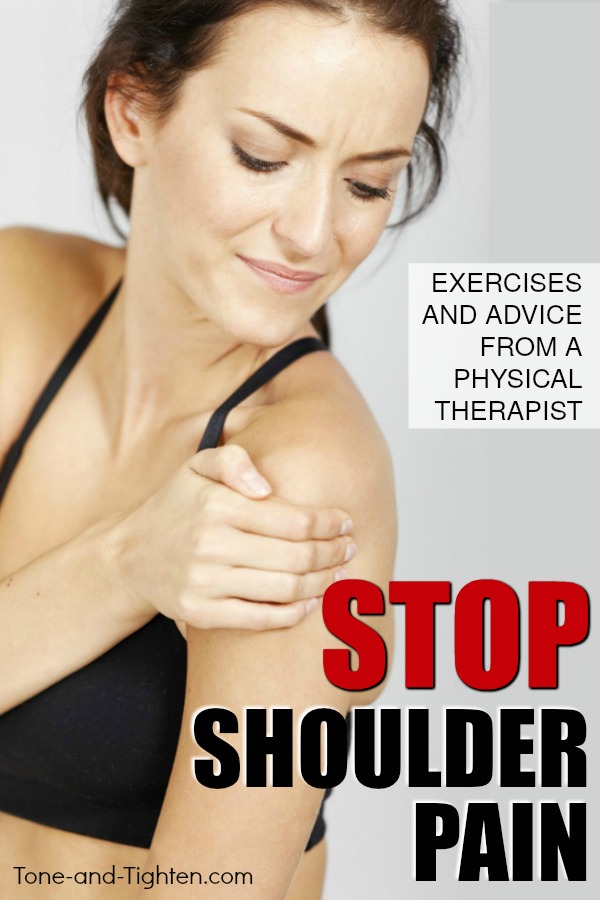6 of the best physical therapy exercises to eliminate shoulder pain. Shoulder impingement is one of the most-common causes of shoulder pain that I encounter in my physical therapy clinic. These are some of the most effective stretches and rotator cuff exercises to stop shoulder pain and help you to feel better.

Your shoulder is the most mobile joint in your body.
Really when you think about everything your shoulder can do with as little support as it has it’s pretty incredible!
That being said, however there’s also a lot of room for error. Things can, and do, go wrong and we often find ourselves with shoulder pain.
Today I wanted to share with you some of my favorite exercises to help alleviate pain due to the most common shoulder condition that I treat – impingement. We’ll talk about what it is, why you get it, and then share about 10 of my favorite stretches and exercises to help you feel better.

SHOULDER ANATOMY
Your shoulder is a ball and socket joint. That “ball” should stay firmly seated in that “socket” during shoulder motions, especially overhead.
If the head of the humerus (the ball) does not stay seated properly in the glenoid cavity (the socket) during motion it can “pinch” on the tendon and other structures up on the top of your shoulder.
Over time, this can lead to pain, inflammation, and even a rotator cuff tear. It’s important that you address the cause of this pain quickly to avoid exacerbating the injury.
WHAT CAUSES MY SHOULDER PAIN?
The primary causes of shoulder impingement include poor posture, muscle weakness, joint tightness, and muscle imbalance. The most effective way to cure this impingement syndrome is to perform exercises that address these deficits.
POSTURE
Posture is probably the number one cause of shoulder impingement. To demonstrate why this is an issue I want you to stand up and slump forward (exaggerate poor posture).
Now try to reach your hands all the way over your head. You won’t be able to do it! You’ll get to about 160 degrees of motion and run into a block.
That’s the impingement I’m talking about. You’re pinching those structures under the roof of your socket and it’s not allowing you to go any further.
Now stand with great posture. Tuck your shoulder blades down and back and make sure your head is squarely over your shoulders. Now reach both arms up in over your head. You should find that you are able to reach a lot higher with a lot less pain.
In order to achieve full overhead motion, your shoulder blade needs to upwardly rotate. This will enable you to achieve those last 20° of motion without pain.
This is why posture is important when we talk about shoulder pain and range of motion.
ROTATOR CUFF STRENGTH
The second primary cause of shoulder impingement that I see in my clinic is rotator cuff weakness. You have 4 muscles that make up the “rotator cuff”.
The primary function of the rotator cuff is to keep the head of the humerus (ball) seated squarely in the middle socket of the shoulder.
Oftentimes muscle imbalance and shoulder/rotator cuff weakness can cause the head of the humerus to move towards the front of the shoulder. During overhead motions, there’s less room under the “roof” in the front of the shoulder than there is in the middle of the shoulder.
This can cause shoulder pain and impingement during overhead motions.
SO WHAT DO WE DO ABOUT IT?
The best things you can do to eliminate shoulder impingement are to stretch the tight structures in the front of the shoulder and chest while strengthening the rotator cuff muscles in the back.
This will promote a better anatomical position for the shoulder joint and enable you to move through these overhead motions with decreased pain and less “pinching” symptoms.
The following video will walk you through my recommended exercises to help alleviate this common shoulder condition. Hit PLAY below and follow along with the exercises in the video!
EQUIPMENT NEEDED FOR THIS WORKOUT:
FOAM ROLLER: https://amzn.to/2Wepsmp
RESISTANCE BAND SET: https://amzn.to/2HZ7aSt
The stretches and exercises that I recommend to patients experiencing this type of shoulder pain include:
1. Doorway Stretches (Low, Middle, and High): great stretch for the front of the chest and shoulders. I like the low position for the pull through the biceps tendon and I like the high position for the additional rotation component.
2. Foam Roller: lay on a 36” foam roller to stretch your chest and shoulders out. If you need to get one you can do so at this link: https://amzn.to/2Wepsmp
3. Scapula Pinches: One of my favorite exercises to correct poor posture and help put your shoulder blades back in the correct position for function.
4. YTA: Easy shoulder and rotator cuff exercises you can do at home with zero equipment required.
5. Resisted External/Internal Rotation: My personal go-to exercises for rotator cuff strengthening. Remember while internal rotation will be strong, functionally speaking external rotation will be more important. Get my favorite set of resistance bands right here: https://amzn.to/2HZ7aSt
You don’t have to struggle with shoulder pain. The right stretches and the right exercises can help improve your shoulder mechanics and decrease your pain. Stay consistent for 4-6 weeks and you’ll be amazed at the results you experience with these exercises!
Here are some of our other popular video that you may find useful:
Follow Tone and Tighten on social media!
Instagram: http://instagram.com/tone_and_tighten
Pinterest: http://www.pinterest.com/ToneandTighten/
Facebook: https://www.facebook.com/toneandtightenfitness
Make it happen,
Jared
